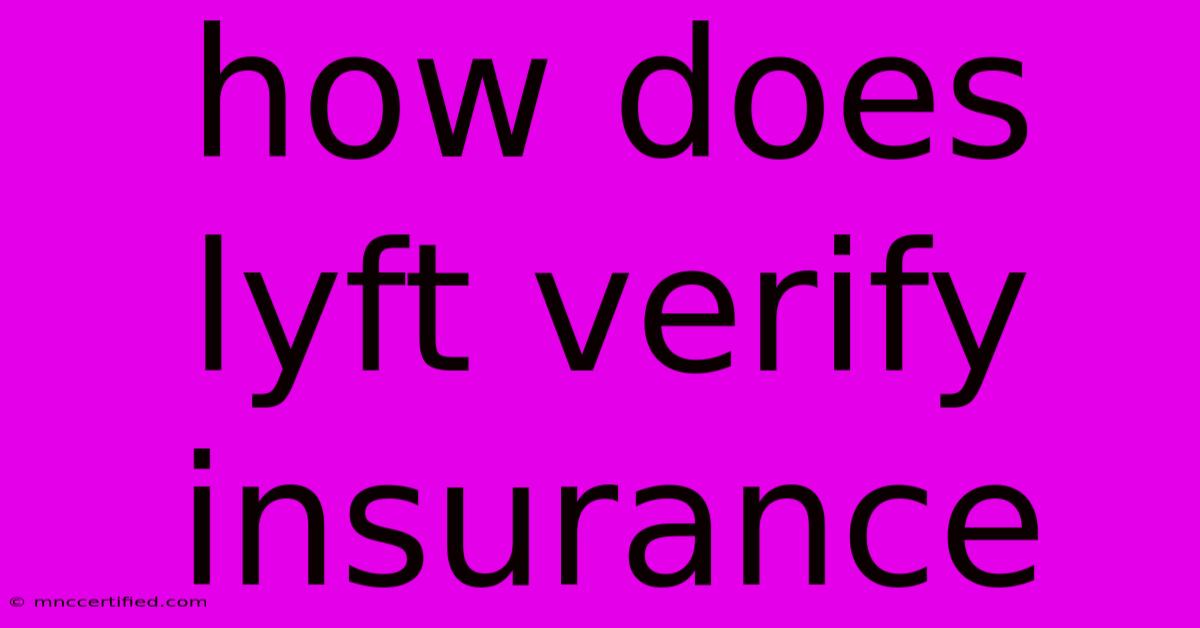How Does Lyft Verify Insurance

Table of Contents
How Does Lyft Verify Insurance? A Comprehensive Guide for Drivers
Lyft, a popular ride-sharing platform, prioritizes safety for both passengers and drivers. A crucial aspect of this safety net is verifying driver insurance. Understanding Lyft's insurance verification process is vital for anyone considering driving with the platform. This comprehensive guide will detail how Lyft verifies insurance, what types of insurance are accepted, and what happens if your insurance isn't up to par.
The Importance of Insurance Verification for Lyft Drivers
Before you even think about accepting your first ride request, understanding Lyft's insurance requirements is paramount. Driving without proper insurance can lead to severe consequences, including:
- Account suspension or deactivation: Lyft will immediately deactivate your account if they detect a lapse in your insurance coverage.
- Financial liability: In the event of an accident, you could face significant financial losses if you are uninsured or underinsured.
- Legal repercussions: Driving without insurance is illegal in most jurisdictions and can result in hefty fines, license suspension, or even jail time.
Lyft's rigorous insurance verification process aims to mitigate these risks.
How Lyft Verifies Your Insurance: The Process
Lyft employs several methods to verify your insurance information:
1. Initial Application & Instant Verification:
During the signup process, you'll be asked to provide your insurance information, including your policy number and insurer's name. Lyft utilizes instant verification technology to check this information against your insurer's database in real-time. This is the first and most immediate check.
2. Periodic Verification Checks:
Lyft doesn't just verify your insurance once. They conduct periodic checks throughout your time as a driver. The frequency of these checks varies, but they ensure your insurance remains active and compliant with their requirements. This ongoing verification helps maintain a safe driving environment.
3. Document Uploads:
While instant verification is the primary method, Lyft may request you upload a copy of your insurance card or policy declaration page. This provides an additional layer of verification and helps resolve any discrepancies detected during automated checks.
4. Third-Party Data Providers:
Lyft works with third-party data providers specialized in insurance verification. These providers access and verify insurance information from various insurance companies, ensuring accuracy and efficiency.
What Types of Insurance Does Lyft Accept?
Lyft requires drivers to maintain a minimum level of liability insurance, and the specific requirements vary by state and region. Generally, the policy must meet or exceed the minimum liability limits set by your state. It's crucial to check your state's regulations and Lyft's requirements before applying. Contact your insurance provider to ensure your policy meets Lyft's standards.
Don't rely solely on Lyft's insurance coverage. Lyft's own insurance policy only kicks in under specific circumstances, usually after your personal policy has been exhausted. Maintaining robust personal insurance coverage is always the best practice.
What Happens If My Insurance Isn't Verified?
If Lyft detects a problem with your insurance, you'll receive a notification. This could range from a request for clarification to immediate account deactivation. Failure to resolve insurance issues promptly can lead to permanent account suspension. It's imperative to address any insurance-related alerts immediately to avoid disruptions in your earning potential.
Proactive Steps to Ensure Seamless Insurance Verification
To avoid any problems with insurance verification, take these proactive steps:
- Maintain accurate insurance information: Update Lyft with any changes to your policy promptly.
- Regularly review your insurance policy: Ensure your coverage remains current and meets Lyft's requirements.
- Keep a digital copy of your insurance card and policy: This will make it easier to provide documents if requested.
- Contact your insurance provider: Ask them to verify that your policy information is correct and that it meets Lyft's requirements.
By understanding Lyft's insurance verification process and taking proactive measures, you can ensure a smooth and problem-free experience as a Lyft driver. Remember, maintaining valid and adequate insurance is not only a requirement but also a crucial step towards responsible driving and the safety of all road users.

Thank you for visiting our website wich cover about How Does Lyft Verify Insurance. We hope the information provided has been useful to you. Feel free to contact us if you have any questions or need further assistance. See you next time and dont miss to bookmark.
Featured Posts
-
Man City 3 3 Feyenoord Match Stats
Nov 27, 2024
-
8 Missing After Egypt Red Sea Boat Accident
Nov 27, 2024
-
Owner Of Twin Towers Insurance
Nov 27, 2024
-
This Morning Viewer Outrage Over Controversial Star
Nov 27, 2024
-
Canada Mexico Defy Trumps Tariff Threats
Nov 27, 2024